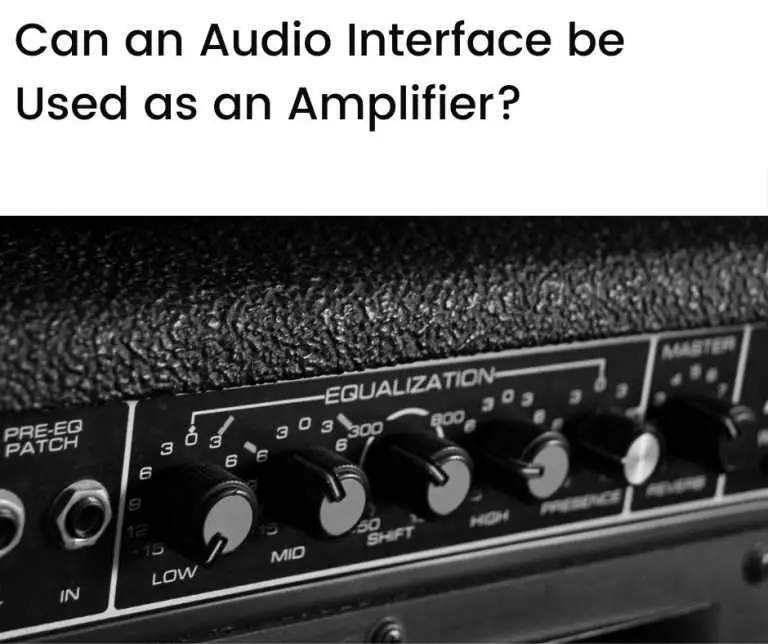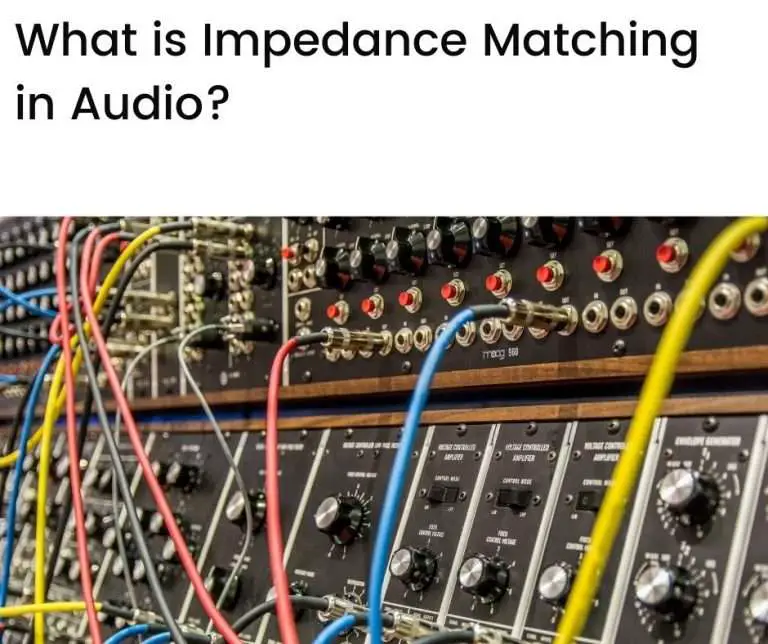A guitar pickup’s impedance is a measure of its resistance to an alternating current (AC) and depends on its resistive, inductive, and capacitive elements. Passive guitar pickups have medium-to-high (output) impedances, typically 5 kΩ – 20 kΩ, and often connect to devices that have very high (input) impedances (i.e., 1 MΩ or higher). Guitar pickups are constructed in various ways, each producing a different tone and quality of sound.
In this article we’ll look at:
- What is the impedance of a guitar pickup?
- How impedance differs from resistance
- Is a guitar pickup high or low impedance?
- Pickup impedance and tone
- Conclusion
What is the impedance of a guitar pickup?
The output impedance of most passive guitar pickups is in the 5 kΩ – 20 kΩ range.
You can think of the output impedance of a guitar as its “resistance” to a fluctuating current flowing through it.
In audio production systems, impedance (rather than resistance) is what matters. This is because the signals in audio systems fluctuate with the frequencies of the audio signals that they’re carrying.
And since guitars produce an output sound (i.e., an audio signal), it’s a pickup’s output impedance that matters when they’re connected to other equipment.
Note that active guitar pickups are also available that have a circuit to boost the (very low) signals that come from guitars—these have a low impedance.
In this article, we discuss passive guitar pickups.
How impedance differs from resistance
Impedance is a version of resistance that applies to alternating currents.
Resistance in an electronic circuit is described by Ohm’s Law:
V = I x R
Here, V is the voltage across the circuit, I is the current that’s flowing through it, and R is the electrical resistance offered to the current by the circuit.
The resistance described above is for a direct current (DC), i.e., a current that does not fluctuate.
As we know, the type of current that flows in audio systems fluctuates and is referred to as an alternating current (AC).
So, Ohm’s Law in the case of AC is described as:
V = I x Z
Here, Z is the resistance that a circuit offers to AC (rather than DC) and is called the impedance of the circuit.
Why is impedance relevant for circuits with AC flowing through them?
Because circuits typically contain three types of elements: resistors, capacitors, and inductors. While resistors react the same way to either DC or AC, capacitors and inductors react differently depending on the type of current that flows through them.
Put simply, capacitors and inductors respond to the fluctuations in a current. So, when AC is applied across a circuit, its impedance will depend on the capacitive and inductive elements within it, in addition to its resistance.
Is a guitar pickup high or low impedance?
The output impedance of a typical passive guitar pickup is medium-to-high (i.e., around 5 kΩ – 20 kΩ).
Although guitar pickups have relatively high (output) impedances, they often connect to devices that have very high (input) impedances, such as amplifiers or hi-z inputs on audio interfaces—these have impedances of around 1 MΩ (i.e., 1,000 kΩ) or higher.
Why do guitar pickups connect to very high impedance devices?
Because when you connect audio devices, the difference in their impedances is what affects the way that audio signals flow between them.
The amount of signal that’s transferred from an output device to a connected input device depends on the relative difference in their impedances.
A 1 kΩ pickup (output impedance), for instance, connected to a 1 MΩ amplifier (input impedance), will transfer 99.9 percent of the audio signal coming from the pickup to the amplifier—all else equal, this is a good thing!
If, however, the amplifier’s input impedance was only 1 kΩ (i.e., the same as the guitar pickup’s output impedance), then only 50 percent of the audio signal is transferred. This isn’t good since we want as much as possible of the signal coming from the pickup to be transferred to the amplifier.
Why we don’t want impedance matching for audio signal connections
The situation we just described, i.e., where the impedance of the guitar pickup and connected amplifier are equal (1 kΩ in the example), is referred to as impedance matching.
You may have heard that impedance matching is a good thing—it can be, but it depends on what you’re doing.
Impedance matching transfers the maximum power between connected electronic devices.
This may be good, for instance, if you connect an amplifier to a speaker—in this case, you may want to transfer as much power as possible, provided the speaker and amplifier are compatible, so impedance matching makes sense.
In other situations, however, your goal is to transfer as much of the audio signal as possible. And as we’ve discussed, for guitar pickups, it’s better to connect to a device with a much higher impedance to transfer most of the signal from the pickup to that device.
Why do guitar pickups have high impedances?
So, if relative impedance differences matter when connecting devices, wouldn’t we want a guitar pickup to have a low, rather than a high, impedance? This would allow an even better transfer of audio signals to connected devices.
A guitar pickup with an output of impedance of 1 Ω, for instance, connected to an amplifier with an input impedance of 1 MΩ would result in 1,000 times the signal transfer of a 1 kΩ to 1 MΩ connection (since 1 Ω : 1 kΩ : 1 MΩ is in the ratio 1 : 1,000 : 1,000,000). Isn’t this a good thing?
Yes—but it’s only a part of the story.
Guitar pickups work by using electromagnetic induction—the vibrating strings of a guitar generate an (AC) electric current in the pickup due to the presence of a magnetic field. The generated AC signal is very weak and has to compete with electronic circuit noise.
So, to pick up as much of the signal as possible, and with enough clarity above the level of electronic noise, guitar pickups use thousands of turns of wire (i.e., 6,000–8,500 turns or more) to produce a strong enough magnetic field. This results in a high impedance.
Pickup impedance and tone
The tone produced by a pickup varies depending on how it’s made: the coil configuration, the number of turns of coil, the types of magnets used, and its dimensions all affect the tone.
Pickups are, ultimately, simple devices: magnets, wire coil, and some plastic and metal. But the way that different pickups are made makes a big difference to the tone of the sound that they produce.
Pickup designs differ in their number of coil windings, the thickness of the wire used, the types and number of magnets used, and the physical dimensions of the pickup, including how close the coil is to the guitar’s strings. All of these affect how the pickup sounds.
The table below summarizes some common coil configurations and magnet types used in pickups with their associated tones.
| Pickup Component | Construction | Tone |
|---|---|---|
| Coil—single | Six magnetic poles, coil, bobbin, output wire | Bright |
| Coil—dual (humbucker) | One coil as for single coil and a second coil with inverted poles—inverse phases cancel noise | Darker top end than single coil with a more aggressive bite |
| Magnets—ceramic | Iron oxide and other metals in a ceramic compound | Strong tones favored by rock and metal guitarists |
| Magnets—alnico (various types) | Alloy of iron, aluminum, nickel, cobalt | Vintage tones with pronounced mid-frequencies, smooth high-frequencies, and tight low-frequencies (depending on the type of alnico magnet used) |
| Magnets—neodymium | Rare earth metal | Pure sounding tone favored by bass guitarists |
The way that the coil is wound also has a big effect on a pickup’s tone. Underwinding a pickup will produce a thin, anemic tone, for instance, while overwinding will produce a muddy and indistinct tone.
Guitarists pay attention to the type of pickup that they use due to tonal differences. Dave Gilmour, Eric Clapton, and Stevie Ray Vaughan, for instance, favor single-coil pickups for their bright tone. Other guitarists, however, favor humbucker pickups, like those produced by Seymour Duncan, for their edgier, more biting tone.
Conclusion
Passive guitar pickups have a medium-to-high impedance, usually around 5 kΩ – 20 kΩ.
Having a relatively high (output) impedance, guitar pickups work best when connected to devices that have a much higher (input) impedance, e.g., amplifiers or audio interfaces with impedances of 1 MΩ or more—this is to transfer a large proportion of the (relatively weak) audio signals coming from pickups.
Guitar pickups are made in various ways using different materials—their construction materials and methods will affect the tone of sound that they produce. This is an important factor for guitarists when choosing the type of pickup they want to use.








Impedance is relative to frequency. It is therefore meaningless to talk about *the* output impedance. Voltage transfer depends not on the difference but the ratio of the impedances.